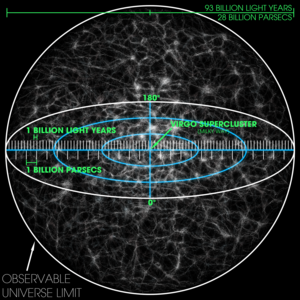
In cosmology, a Hubble volume (named for the astronomer Edwin Hubble) or Hubble sphere, Hubble bubble, subluminal sphere, causal sphere and sphere of causality is a spherical region of the observable universe surrounding an observer beyond which objects recede from that observer at a rate greater than the speed of light due to the expansion of the universe.[1] The Hubble volume is approximately equal to 1031 cubic light years (or about 1079 cubic meters).
The proper radius of a Hubble sphere (known as the Hubble radius or the Hubble length) is , where is the speed of light and is the Hubble constant. The surface of a Hubble sphere is called the microphysical horizon,[2] the Hubble surface, or the Hubble limit.
More generally, the term Hubble volume can be applied to any region of space with a volume of order . However, the term is also frequently (but mistakenly) used as a synonym for the observable universe; the latter is larger than the Hubble volume.[3][4]
The center of the Hubble volume and observable universe is arbitrary in relation to the overall universe; instead it is centered around its origin (impersonal or personal "observer").
The Hubble length is 14.4 billion light years in the standard cosmological model, equivalent to times Hubble time. The Hubble time is the reciprocal of the Hubble constant,[5] and is slightly larger than the age of the universe (13.8 billion years) as it is the age the universe would have had if expansion was linear.[6]
- ^ Edward Robert Harrison (2003). Masks of the Universe. Cambridge University Press. p. 206. ISBN 978-0-521-77351-5.
- ^ N. Carlevaro & G. Montani (2009). "Study of the Quasi-isotropic Solution near the Cosmological Singularity in Presence of Bulk-Viscosity". International Journal of Modern Physics D. 17 (6): 881–896. arXiv:0711.1952. Bibcode:2008IJMPD..17..881C. doi:10.1142/S0218271808012553. S2CID 9943577.
- ^ For a discussion of why objects that are outside the Earth's Hubble sphere can be seen from Earth, see TM Davis & CH Linewater (2003). "Expanding Confusion: common misconceptions of cosmological horizons and the superluminal expansion of the universe". Publications of the Astronomical Society of Australia. 21 (1): 97–109. arXiv:astro-ph/0310808. Bibcode:2004PASA...21...97D. doi:10.1071/AS03040. S2CID 13068122.
- ^ For an example of mistaken usage, see Max Tegmark (2004). "Parallel Universes". In Barrow, J. D.; Davies, J. D.; Harper, C. L. (eds.). Science and Ultimate Reality: From Quantum to Cosmos. Cambridge University Press. pp. 459ff. ISBN 978-0-521-83113-0.
- ^ Hawley, John F.; Holcomb, Katherine A. (2005). Foundations of modern cosmology (2nd ed.). Oxford [u.a.]: Oxford University Press. p. 304. ISBN 978-0-19-853096-1.
- ^ Ridpath, Ian (2012). A Dictionary of Astronomy (2nd ed.). Oxford University Press. p. 225. doi:10.1093/acref/9780199609055.001.0001. ISBN 9780199609055.



